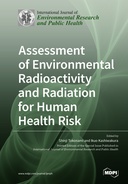Explore

Assessment of Environmental Radioactivity and Radiation for Human Health Risk
0 Ungluers have
Faved this Work
Login to Fave
Ten years have passed since the nuclear accident occurred in Fukushima, Japan, following the Great East Japan earthquake. Thereafter, many people around the world have been concerned about the risks posed by radiation. They still believe that even a small amount of radiation exposure will affect human health. In reality, however, there are many natural radionuclides in the environment, which emit a variety of types of radiation. Although it is well known that there is a positively linear relationship between acute radiation exposure and cancer risk in atomic bomb survivors, the risk of chronic radiation exposure due to natural radionuclides cannot be well explained to people who have lived in high-background radiation areas for many generations. Therefore, more studies in this research field are required to obtain new scientific findings. In order to promote further scientific activities, it will be the best for us to understand the current status of this field by summarizing what we have apprehended so far. This Special Issue will highlight measurement data, methodologies, radiation biology, and risk assessment related to radiation.
This book is included in DOAB.
Why read this book? Have your say.
You must be logged in to comment.
Rights Information
Are you the author or publisher of this work? If so, you can claim it as yours by registering as an Unglue.it rights holder.Downloads
This work has been downloaded 115 times via unglue.it ebook links.
- 115 - pdf (CC BY) at Unglue.it.
Keywords
- 220Rn progeny
- 222Rn progeny
- 226Ra
- 228Ra
- 238U
- air dose rate
- air-exchange rate
- artificial radionuclides
- Biography & True Stories
- bottled water
- cesium-134
- cesium-137
- chemical composition
- contaminated water
- CR-39
- deposition velocity
- detection limit
- deuterium plasma experiment
- Development
- dietary intake
- difficult-to-return zone
- dose
- dose assessment
- effective dose
- effective dose rate
- Environment
- equilibrium equivalent concentration
- evacuation order-lifted areas
- exhalation rate
- external exposure dose evaluation
- external exposure risk
- free-roaming cat
- Fukushima
- Fukushima accident
- Fukushima Daiichi Nuclear Power Plant
- Fukushima Daiichi Nuclear Power Station accident
- fusion test facility
- gamma radiation
- geography information systems
- Geology
- Groundwater
- guidance level
- health risk
- hot spring
- indoor
- indoor environment
- ingestion
- internal contamination
- Japan
- limestone aquifer
- Living Space
- long-term measurement
- measurement technique
- monthly precipitation
- Namie Town
- nationwide survey
- natural radionuclides
- northern Vietnam
- Okinawa Island
- passive radon monitor
- potassium-40
- Public Health
- Radioactive cesium
- Radioactivity
- radiocesium
- radiological hazards
- Radon
- radon concentration
- radon mapping
- radon potential map
- REE and uranium mines
- reproductive organ
- residence time
- residential exposure
- Risk
- seasonal variation
- seawater monitoring
- sensitivity
- SSNTD
- strontium-90
- surface soil
- thema EDItEUR::D Biography, Literature and Literary studies::D Biography, Literature and Literary studies::DN Biography and non-fiction prose
- thoron
- thoron progeny
- Tomioka town
- total diet study
- tritium monitoring
- well water
- WHO
Links
DOI: 10.3390/books978-3-0365-1224-2Editions

